   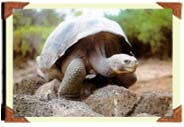 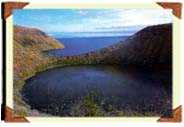 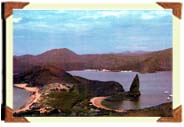 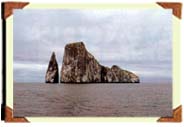 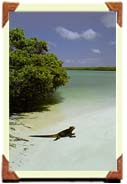 |
  When the tourist reaches Galapagos, his eyes shine in wonder over so much beauty at the same time. It is like a dream from which it would be a pity to wake up. There is no doubt that the islands are a true living laboratory for the scientists of all times. This scenario of wild life and volcanos is 1.000 Km away from the coast of continental Ecuador and is composed of 13 islands and dozens of islets and reefs, a refuge for different species. Our islands are washed by several currents and marine masses with temperate and tropical temperatures, thanks to these factors, the islands have a great variety of habitats and land and marine ecological systems. MUSEUMS: The Francisan Mission (Island of San Cristobal) CHURCHES: Cathedral of the Virgin Mary (Island of San Cristobal) Saint Marianita (Island of Santa Cruz) Dios Creador (Isabela Island) TOURING THE ISLANDS SANTIAGO.- This name is equivalent to Saint James in English, it is also known as San Salvador,the name of the first island discovered by Columbus in the Caribbean Sea. Area: 585 Km2 Maximum Altitude: 900 meters above sea level. Here we find animals such as marine iguanas, sea lions, two-fur sea lions, sparrow hawks, land and sea turtles, flamingos, dolphins and sharks, you will also find a great quantity of goats and pigs, animals which were brought to the islands and which have caused great harm to same. BALTRA.- (S. Seymour). The origin of the name is unknown. Area: 27 Km2 Maximum Altitude approximately 100 meters above sea level. We will find animals such as land iguanas, marine iguanas and marine turtles. PINTA.- ( Abingdon). It got its name from one of the caravels of Columbus. AREA: 59 Km2 Maximum Altitude: Approximately 635 m.a.s.l. We will find animals such as split tail seagulls, marine iguanas, sparrow hawks, and two-fur sea lions. FLOREANA.- (Charles. Santa Maria). It was named after Jose Flores, the first President of Ecuador, during whose administration the government of Ecuador took possession of the island. It is also called Santa Maria after one of the caravels of Columbus. Area: 173 Km2 Maximum Altitude 550 m. a.s.l. Here we find flamingos, tropical birds, sea lions and, high up in the mountains, a bird in danger of extinction the "joint footed" petrel, a nocturnal sea bird which spends most of its life away from land. WOLF.- (Wenman). It got its name from the German geologist Theodor Wolf. Area: 1.3 Km2 Maximum elevation: 253 m a.s.l. You will be seeing two-fur sea lions, frigates, masqued and red footed boobies, marine iguanas, sharks, whales, dolphins and split tailed sea gulls. ISABELA.- (Albemarie). Name given in honor of Queen Isabela who sponsored the voyage of Columbus. Total Area: 4.588 Km2 Area of South Isabela: 2.472 Km2. Area of North Isabela: 2.112 Km2 Maximum elevation: Approximately 1.689 m a.s.l. (Cerro Azul) Maximum elevation: 1.707 (Wolf Volcano). Here we find animals such as sea lions and two-fur sea lions, marine turtles and the giant Galapagos, land and marine iguanas, non flying cormoranes, penguins, boobies. flamingos, sparrow hawks, split tail seagulls, dolphins, whales, sharks, blue and masqued. ROCA REDONDA.- Bears this name because it resembles the sail of an old vessel called "Redonda". Area: Unknown Maximum Altitude: 70 m above sea level. The animals found here are whales, dolphins, sharks, sea lions, masqued boobies and tropical birds. FERNANDINA.- (Narborough). The name was given in honor of King Fernando of Spain, who supported (sponsored) the voyage of Columbus. Area: 642 Km2 Maximum Altitude: 1.494 m. a.s.l. Here we find the following animals: sea lions, split tail sea gulls, tow-fur sea lions, sparrow hawks, marine iguanas, whales, penguins, cormorans that don't fly, sharks and land iguanas. MARCHENA.- (Bindloe). It is named after Fra. Antonio Marchena Area: 130Km2 Maximum Altitude: 340 m. a.s.l. We can see the following animals: sparraw hawks, sea lions. BARTOLOME.- It is named after Lt.David Bartholomew of the British Navy which in Spanish is Bartolome. Area: 1.2 Km2 Maximum altitude: 114m. a.s.l. We have here a volcanic landscape, penguins, marine iguanas, marine turtles, sharks and sea lions. PLAZA SUR.- It is named in honor of a former president of Ecuador, General Leonidas Plaza. Area: 0.13 Km2 Maximum altitude: 25 m. a.s.l. Here there are: land iguanas, sea lions, tropical birds, split tail seagulls, and marine iguanas. SEYMOUR NORTE.- Its name was given after an English nobleman called Lord Hugh Seymour. Area. 1.9 Km2 Maximum altitude: approx. 30 m. a.s.l. Inhabited by: Marine iguanas, sea lions, tropical birds, split tail seagulls. GENOVESA.- (Tower). The name is derived from Genova, Italy where it is said Columbus was born. Area: 14 Km2 Maximum Altitude: approx. 30 m. a.s.l. These islands are inhabited by red footed and masqued boobies, tropical birds, two-fur sea lions, marine iguanas, split tail seagulls, sharks and frigate birds. SAN CRISTOBAL.- (Chatham). It proudly bears the name of the Patron Saint of seafarers, "St. Christopher" the other name of this island is: CHATHAM after the English nobleman Count Chatham. Area: 528 Km2 Maximum Altitude: 730 m a.s.l We tour the island following the marked paths and find: frigate birds, sea lions, giant turtles, blue and red footed boobies, tropical birds, marine iguanas, dolphins, split tail seagulls and a vegetation such as Calandrina Galapagos and Lecocarpus Darwinii, trees such as Lignum Vitae, Matazarno, etc. Also the Laguna del Junco. On this Island is situated the Corporacidn Ecuatoriana de Turismo CETUR. RABIDA.- (Jervis). It bears the name of the convent of Rabida where Columbus left his son during his voyage to the Americas. Area: 5 Km2 Maximum Altitude: 340 m. a.s.l. This is the habitat of flamingos, sea lions, marine iguanas and sparrow hawks. PINZON.- (Duncan). It is named after the Pinzon brothers, captains of the Pinta and Nina Caravels. Area: 18 Km2 Maximum Altitude: 435 m a.s.l. Here you will find sea lions, sparrow hawks, giant turtles, marine iguanas and dolphins. ESPANOLA.- (Hood). This name was given in honor of Spain. It is also known as Hood after an English nobleman. Area: 60 Km2 Maximum Altitude: 220 m. a.s.l. Here we find albatrosses, sparrow hawks, marine turtles, masqued boobies, marine iguanas, sharks, sea lions, split tail seagulls, giant turtles, tropical birds and blue footed boobies and also the "Hueco Soplado". DARWIN.- (Culpepper). This island is named after Charles Darwin. Area: Approx. I km2 Maximum altitude: 168 m a.s.l. We will see animals such as two-fur sea lions, frigates, marine iguanas, split tail sea gulls, sea lions, Whales, marine turtles, dolphins, red footed and masqued boobies. DAPHNE.- The same name as the English vessel, the H.M.S. Daphne Area: 32 Has. Maximum Altitude: 120 m a.s.l. Tropical birds, blue footed and masqued boobies, sharks and frigates. SANTA FE.- (Barrington). Named after a city in Spain. Area- 24 Km2 Maximum Altitude: 255 m. a.s.l. The animals here are: Sparrow hawks, land iguanas, sea lions, sharks and marine iguanas. SANTA CRUZ.- Area: 986 Km2 Maximum Altitude: 870 m. a.s.l. The National Galapagos Park, Charles Darwin Scientific Station and Corporacion Ecuatoriana de Turismo CETUR are on this Island. Here we can see sea lions, marine iguanas, giant turtles, frigates, land iguanas, flamingos, dolphines, two-fur sea lions, marine turtles and sharks. The following endemic vegetation is to be found here, papaya trees, tunas, cacao plants, cactus, in native plants we can observe mangroves, "muyuyo", myrtle, "matazarnos". |
